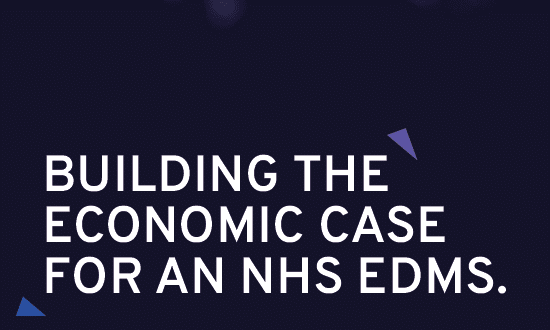Industry Spotlight: Jon Pickering, Mizaic CEO
- 12 January 2024

The NHS is a tough environment for all suppliers at the moment – but for Mizaic CEO Jon Pickering, 2024 is full of exciting possibilities. By Jennifer Trueland
As CEO of Mizaic (formerly IMMJ Systems), Jon Pickering is naturally confident that electronic document management systems (EDMS) are the way to go. Unlocking the huge potential of data from historical patient records brings immense benefits to healthcare, he says, giving clinicians a full and true view of the patient in front of them. It also allows trusts to repurpose vast slices of hospital real estate – currently drowning in paper records – to expand clinical areas.
A growing number of trusts are also convinced that this is the way to go. While the business case and ROI are strong, finding the funding to undertake these projects can be tricky in today’s tough economic times.
“No customer we’re speaking to, or have spoken to in the last 12 months, has said no, they don’t want our solution,” says Pickering, referring to Mizaic’s MediViewer EDMS technology. “They want to buy it, but they need to work out how to fund it.
“In 2024, we’re going to continue our strategy – we know we’re on the right path.”
Last year was big for Mizaic – the name is a play on the word “mosaic” reflecting the concept that its technology ingests data from different sources to create a fuller “picture” of a patient. For one thing, the company rolled out version six of its application, involving a new enhanced software architecture, and revamped user interface aligned with clinician feedback. It also underwent a major relaunch, including a name change.
“The rebrand and relaunch was more than just a refresh of the look and feel – it was about looking at everything that we are and want to be as a business,” explains Pickering. “We feel that we really captured that. It was a rewarding experience when we launched it and the reaction we got was probably the highlight of the year. But that was just part of setting the platform ready for our future success.”
Customers liked the rebranding, he says, possibly because they were kept on board throughout the process. “Our name previously was pronounced in many different ways by different customers,” he smiles. “So that was one thing. But, more importantly, we involved the customers in helping us to define what we wanted the brand to be in the first place. We made sure we got an external perspective on what they liked about working with us, what they felt was good about the business – all sorts of things. So we knew it was going to land well because of input from customers as well as involving every single one of our staff.”
Input from CCIOs
Continuing and expanding this conversation with customers is an important priority for 2024, says Pickering. This includes continuing to liaise closely with trusts to help them build a business case for investing in the technology but also in working with them after deployment.
“We’ve formed a clinical advisory group that’s made up of seasoned, experienced CCIOs from across our customer base. They are going to provide input and feedback on our future product direction to ensure it’s aligned with what clinicians want,” he says. “That’s going to be a key part of how we work going forward because our purpose and vision is to transform the clinician-patient experience at the point of care. The best way for us to do that is to get clinicians involved in how we develop our roadmap so that it best serves their needs and aspirations.”
Existing customers are already experiencing benefits, he says, pointing to London North West University Healthcare NHS Trust as an example. It digitised more than 200,000 patient records, freeing up three medical records libraries, and enabling creation of new aseptic clinical areas. Significant savings can be made in the numbers of people required to move paper round hospitals, as well as releasing space, Pickering says, but this isn’t the only advantage.
Better clinical outcomes
“Fundamentally there’s an enormous business benefit because the NHS are spending anywhere between £1 million and £3 million per year per trust on managing paper medical records and our technology helps eliminate much of those costs,” he explains. “But moving beyond that, it’s about delivering better clinical outcomes.”
Time-poor clinicians benefit from having the content of the patient’s clinical record in front of them – and instantly searchable, rather than ploughing through hundreds of pages of hand-written notes in paper records that can be many inches thick.
Making greater use of AI to make this process even easier is another priority for Mizaic this year, says Pickering. New developments include a new Subject Access Request (SAR) solution which uses RPA (robotic process automation) to speed up manual intensive tasks associated with responding to the constant stream of Subject Access Requests. “This will add further value to the customer and help significantly reduce time and costs associated with managing that process in hospitals.”
Other AI capabilities will be introduced soon, including handwriting recognition and making it easier for clinicians to interrogate historic health information – important not just in terms of giving a more complete picture of the patient in front of them, but also because of its potential for wider population health insights.
Although Mizaic will also be looking at expanding into international markets, Pickering promises there will be no defocus on the NHS. “Any business operating in the NHS at the moment will be finding it challenging, but that will remain our core market,” he stresses.
“There’s a lot of excitement in the business. The key things for this year are that we will continue to focus on what we do best, and we know that our solution can add value to every NHS trust. We’ll continue to work with them on how they can enable that from a budgetary perspective in whatever way we can.”
Contact Mizaic:
Website: www.mizaic.com
LinkedIn: Mizaic
X (formerly Twitter): @mizaic_




